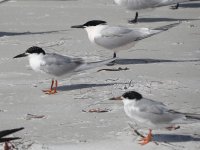See first reply in thread
Ok, yes I saw that. However, I usually expect Common Terns to look noticeably darker when side by side with Sandwich Tern. The bird on the right looks similar in tone, and the one on the left just a tad darker, but it's not as striking a difference as you'd expect between Common and Sandwich.
I'm a little wary of judging grey tones accurately from photos-they can appear darker than in reality, but conversely they can also look much paler. Yet I keep coming back to the apparent lack of contrast with the Sandwich Tern (actually now Cabot's Tern!)
The grey-centred tertials are another thing that don't appear to fit Common (but typical of imm Forster's). Likewise the very white underparts.
The primaries don't look so strikingly pale as we'd expect for adult Forster's, but from my reading, 2cy (and perhaps also 3cy) would have darker grey primaries than adults. They just don't appear as dark as I'd expect for Common Tern! and interestingly, they all appear to be of the same generation (Common usually show obvious contrast between outer and inner primaries).
I considered that 2cy Common might not develop the pale grey breast and belly, and presumably this could also apply to transitional adults. However, 2cy Common Tern would also very likely show the remnants of a darker carpal on the folded wing. Neither bird here has that.
Would like to see other images if they exist...? but for now I'd favour Forster's. I'm slightly less certain of the bird on the right.





